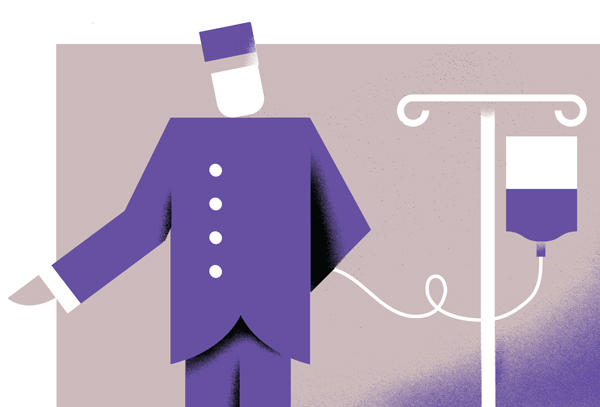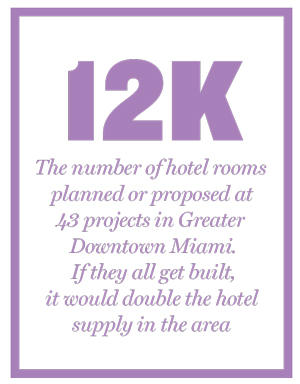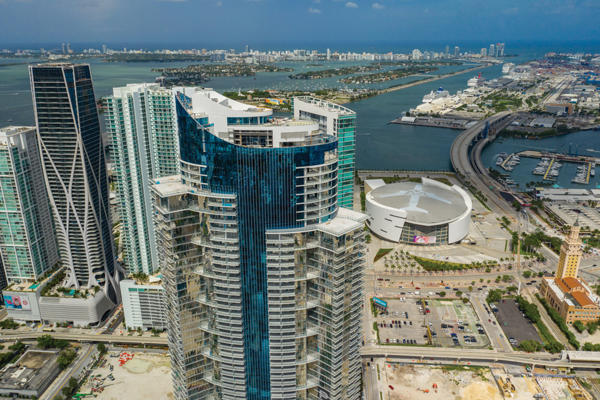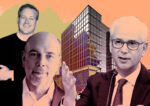Trending
How much are hotels hurting?

During a recent earnings call, Starwood Property Trust CEO Barry Sternlicht broached a touchy topic in the real estate world: the possibility of a recession.
The head of the $56 billion real estate investment trust told investors and analysts that “the only thing we have to worry about is a calamitous recession,” warning of a slowing economy largely thanks to the national political environment.
Specifically, Sternlicht said Starwood needs to be “uber-careful” in the hotel sector because of a potential oversupply.
Developers have, in fact, been churning out hotels at a blistering pace. And Miami is one of several U.S. cities that’s seen a boom in hotel construction.
READ MORE IN THIS SERIES:
There are more than 12,000 hotel rooms planned or proposed at 43 projects in Greater Downtown Miami alone, including the 1,700-room Miami Worldcenter hotel and convention center and the 800-room Miami Beach Convention Center Hotel.
If all of 12,000 of those rooms get built — only about 400 are currently under construction — it would double the hotel supply in Brickell, Downtown Miami, the Arts & Entertainment District, Edgewater, Midtown, Overtown and Wynwood, according to the Miami Downtown Development Authority, an independent agency that advocates for economic growth.
By comparison, there are 7,500 rooms under construction in Los Angeles and 14,000 in New York, according to real estate research firm STR.
But some may be seeing the writing on the wall in Miami.
Starwood and partner LeFrak, for example, sold the 1 Hotel South Beach for $610 million in February. And designer Tommy Hilfiger along with the Dogus Group sold the 84-key Raleigh Hotel, also in South Beach, for $103 million, or $1.24 million per key. (Of course, the buyers on those deals — Host Hotels & Resorts for the 1 Hotel and developer Michael Shvo for the Raleigh — are still making large bets on South Florida hospitality.)
 Jim Butler, who chairs the global hospitality group at L.A.-based law firm Jeffer Mangels Butler & Mitchell, said that there is good reason to invest in “irreplaceable locations and buildings” for the long term. But, he said, pricing for properties around Miami and nationally has generally peaked, making it a good time to sell.
Jim Butler, who chairs the global hospitality group at L.A.-based law firm Jeffer Mangels Butler & Mitchell, said that there is good reason to invest in “irreplaceable locations and buildings” for the long term. But, he said, pricing for properties around Miami and nationally has generally peaked, making it a good time to sell.
“It’s still a good market and they’re getting good prices,” he said. “It’s great to diversify risks and good to be taking chips off the table.”
How many chips to take off the table is the big question.
The hospitality industry has historically been a canary in the coal mine — one of the first segments in real estate to get hit when the market starts turning. That’s because it’s low-hanging fruit for both consumers and businesses to cut back on hotel stays.
In the wake of the 2008 financial crisis, the key metric for gauging hotel performance — revenue per available room, or RevPAR — plummeted across the country.
South Florida saw a nearly 21 percent decline in RevPAR between its 2008 peak and 2009, according to STR. New York fared even worse, with a 27 percent year-over-year decline during that stretch.
And there are already some red flags this time around, including the oversupply of rooms and a drop in RevPAR growth, suggesting that the hotel sector is exposed both nationally and in South Florida.
While RevPAR is still growing, the amount it’s growing by is dropping.
In August, STR adjusted its projected 2020 RevPAR growth nationally — downgrading it to 1.1 percent from the 1.9 percent it had projected in June. It also downgraded projections for this year.
While economists have been chattering about an economic downturn for a while, all signs now suggest that it’s imminent. Most economists expect the recession to really hit in 2020, which is predicted to be a particularly hard year for the hotel industry.
The Federal Reserve Bank of New York’s recession probability indicator — which gauges the likelihood of a recession within the coming 12 months — skyrocketed from around 10 percent at the beginning of 2019 to 37.9 percent in August.
Oversupply is a key concern for existing hotel owners in a recession, said attorney Joshua Bernstein, co-chair of the hospitality sector team at the law firm Akerman. Established hotels and brands are better positioned to weather a downturn, he said.
“New supply is generally a greater risk for [owners of less established properties] because they have no existing reputation in the market and no cash flow to rely on, so they’re at risk of some large debt liabilities,” he said.
Exposure and opportunities
In Miami, developers and lenders have yet to show much concern about a potential turn in the market.

Miami Worldcenter
Aria Development and the Kuwait Real Estate Company — aka AQARAT — recently snagged a $76.3 million construction loan from the Arkansas-based Bank OZK for their YotelPad Miami, which includes a 222-key hotel and 231 condos.
Meanwhile, Kevin Maloney’s Property Markets Group and partners landed a $33 million pre-development loan for the Waldorf Astoria Hotel & Residences Miami — which will include a 140-key hotel and 400 condos — in late 2018.
And the Netherlands-based citizenM is planning a 348-room hotel on a parcel it bought in Downtown Miami from Miami Worldcenter Associates.
In addition, while underwriting is tighter than it was before the last downturn, CMBS debt is still available, said Manus Clancy, a senior managing director at Trepp, which tracks securitized mortgages.
Overall, CMBS originations are down 10 percent this year compared to 2018, but Clancy said many owners may be insulated this time around by long-term financing that will carry them through a recession.
Clancy said that to some extent the narrative of a looming recession “has got ahead of the reality.” But, he said, there’s a consensus that the unprecedented 10-year economic expansion is nearing its end.
Opinions differ on whether the expansion still has fuel in the tank — or if the economy is at the start of a downturn.
“There’s one perspective that we’re in the eighth inning of the rally,” Clancy said. “But some people think we’re in the first inning of a recession where the first pitch really hasn’t been thrown yet.”
So far, CMBS loans for hospitality properties in South Florida appear to be healthier than they are in other major markets, including New York and L.A. There is around $3.8 billion worth of securities on hotels in the region, and none of those mortgages are in delinquency — meaning more than 30 days behind payment, nonperforming beyond maturity, in foreclosure or real estate owned by a lender (aka REO) — as of early September, according to Trepp.
By comparison, around 2.6 percent of the $3.9 billion in hotel-backed CMBS loans in L.A. are in delinquency, as are 7.7 percent of the $3.9 billion in New York.
 But while SoFla’s market seems healthy now, the oversupply could amplify the pain if the market drops.
But while SoFla’s market seems healthy now, the oversupply could amplify the pain if the market drops.
Revenues have risen steadily each year since 2013, but occupancy rates in Miami-Dade County were down 1.5 percentage points in 2018 to 76.7 percent compared to five years prior, thanks mostly to construction. Miami Beach seems particularly overheated, with occupancy down 2.8 percentage points to 75.9 percent.
Boaz Ashbel, managing director at the investment banking firm Aztec Group told the Wall Street Journal in March that a decline in travel from Latin America is also impacting hotels.
Rafael Serrano, managing director at Miami-based Safe Harbor Equity, said that over the last four months his firm has identified three Miami Beach hotel assets that appear to be in distress.
In May, the firm launched a $100 million distressed commercial real estate debt fund. It doubled its target a month later after garnering strong interest during fundraising tours in Europe and Asia.
Serrano said the fund — which will target all commercial assets, including hospitality and retail properties — is focusing on South Florida but will also look to other major markets including New York, Texas and California.
Safe Harbor’s goal is “to be well-positioned for the oncoming economic headwinds that are being forecasted,” he said in May.
Serrano said Miami-area loans modified in the last five to seven years are coming due and that borrowers may run into trouble if customers pull back and fundamentals weaken.
“It’s very reasonable to expect there would be an increase in defaults,” he said. “I think a lot of [hotels] are highly levered, and it wouldn’t surprise me in the least.”
A recession may not even be the most pertinent challenge ahead for hotel builders.
Construction and labor costs are already contributing to struggles for developers in New York, Miami, California and elsewhere.
“I think the scariest thing is that costs right now are for the first time in years going up faster than RevPAR, particularly for labor,” said Butler, speaking about the national landscape but also noting that it’s a concern in Miami given the oversupply.
Butler said it’s crucial for hotel investors to be capitalized going into a downturn. That way, if occupancy or RevPAR drops, owners can wait out the market until those properties bounce back.
“The best thing you can do to prepare for a downturn is make sure you have ample equity and funding,” Butler said. “The hotel industry is cyclical — they’re going to be back, but if you can’t get through the downturn, you could lose your property.”
He noted that when consumer and corporate clients start to cut back on expenses, the luxury hotel industry tends to cut room rates. That, he said, contributed to the hotel sector’s problems during the Great Recession and creates a “suicidal” downward spiral. Hotel owners would be wise to hold steady on pricing in the event of a slowdown, he said.
Black swans
Both the hotel and retail sectors have been underperforming for some time now.
In 2017 and 2018, national RevPAR growth was the weakest it’s been since the recession — around 2.9 percent annually, according to STR.
Douglas Hercher, principal and managing partner of hospitality investment banking firm RobertDouglas, cautioned that the recent declines in fundamentals are more a function of “oversupply” and “post-peak pricing” than a recession.
“What we haven’t seen in a way that I would be willing to say demonstrates — or is evidence of — a recession,” said Hercher, who arranged $20 million in renovation financing for the Raleigh in 2011. “Declines in [room rates] and occupancy that appear to be a function of a drop in demand instead of new supply or unwillingness to pay higher [rates].”
The consensus seems to be that when the next recession hits, it will be far less severe than the last one. But Butler noted there are always unknowns.
“I am not pessimistic, I am optimistic,” he said. “But over the years, I’ve been through some cycles where there is an event that isn’t quite as big as a black swan, and we never see it no matter how hard we look. We never see it.”




